|
TREATING AGGRESSION IN A GROUP OF DOMESTIC CATS
The story of a Socialisation Program
Norwegian Forest cats - Dr David Sands
(All photographs courtesy of John and Chris)
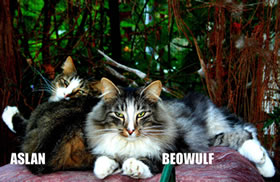 In October 2008 Chris from North London contacted our clinic to ask for help. After the loss of a beloved Norwegian Forest cat from a happy group of three Chris and his brother John had attempted to introduce their two adult cats , Beowulf and Aslan, to a new young Norwegian Forest kitten called Sammy. A war of attrition, including chase and aggression, had developed between Beowulf and the kitten. Chris explained the problem to Dr David Sands: In October 2008 Chris from North London contacted our clinic to ask for help. After the loss of a beloved Norwegian Forest cat from a happy group of three Chris and his brother John had attempted to introduce their two adult cats , Beowulf and Aslan, to a new young Norwegian Forest kitten called Sammy. A war of attrition, including chase and aggression, had developed between Beowulf and the kitten. Chris explained the problem to Dr David Sands:
“Three boys in litter and we bought all three, Beowulf, Braqui and Aslan. They were never separated until one of them, Braqui, passed away from FIP at about 18 months old. Beowulf and Braqui used to sleep together on my bed cuddled up’.
“After about six months from the date we brought the three kittens home, we were given a fourth cat by the same breeder; a three-and a-half-year old female Norwegian Forest Cat. After a while, she dominated my attention when Beowulf, Braqui and myself went to bed. A few months after Braqui passed away, I returned the female to the breeder and bought another male Norwegian Forest Cat, whom we named Sammy ”.
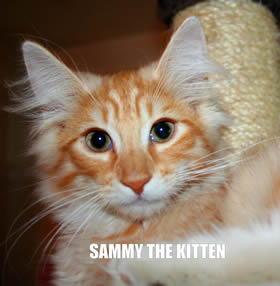 “From the onset Beowulf attacked Sammy. Beowulf has always been a sweet and friendly cat, who loves to cuddle. I thought he would love the kitten and cuddle with him the way he did with his late brother, Braqui. Instead, Beowulf has become homicidal towards Sammy (whereas Aslan has accepted him) and we have been keeping them separated ever since. “From the onset Beowulf attacked Sammy. Beowulf has always been a sweet and friendly cat, who loves to cuddle. I thought he would love the kitten and cuddle with him the way he did with his late brother, Braqui. Instead, Beowulf has become homicidal towards Sammy (whereas Aslan has accepted him) and we have been keeping them separated ever since.
The problem is just between Beowulf and Sammy.”
Dr Sands asked them general questions about the cats, if and how they accessed the outside world and about Sammy’s background:
“We have a part of the garden sectioned off, with netting on all sides, including the top. There is scope for fresh air, with a fair distance for running around, but not for leaving and wandering off.”
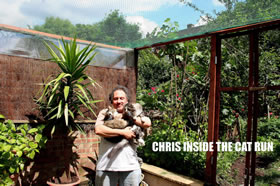 “Sammy was raised by the breeder in a nice, small room, with his two sisters and their mother. Sammy was not mixed with the other cats in her household. And as far as I know, the only other human contact Sammy has had was with the breeder’s twelve year-old daughter. “Sammy was raised by the breeder in a nice, small room, with his two sisters and their mother. Sammy was not mixed with the other cats in her household. And as far as I know, the only other human contact Sammy has had was with the breeder’s twelve year-old daughter.
Sammy found his new environment (my house) very stressful for about two weeks. It was clear he was missing his sisters and his mother. His problem was exasperated by Beowulf, who caught him within the first few days of his arrival, and locked with him in a vicious battle. No physical harm was done to my amazement, but the attack gave Sammy additional stress. Sammy is now a care-free and happy kitten, who plays with everyone and also with our other cat, Aslan. Sammy is always care-free, except when he thinks that Beowulf is around. Beowulf, on the other hand, does not display any stress or aggression, and is care-free and happy – except when he thinks he has a chance to get hold of Sammy. His personality then changes, turning from Dr Jeckle into Mr Hyde.
Since the arrival of Sammy, Beowulf has sprayed just once. This was all around my bed, as though he was laying his claim to me. Every night, I cuddle Beowulf on my bed extensively. During the day, we all hug him and play with him.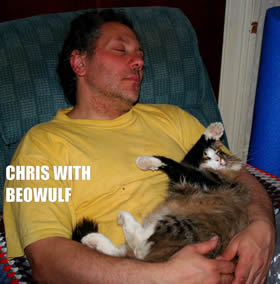 He has no reason to feel he is less loved because of the arrival of the kitten, Sammy. If anything, we have consistently been giving Beowulf much more attention than usual in the hope of making him feel more secure, but this has not made a difference.” He has no reason to feel he is less loved because of the arrival of the kitten, Sammy. If anything, we have consistently been giving Beowulf much more attention than usual in the hope of making him feel more secure, but this has not made a difference.”
With the background history and information we made a preliminary diagnosis. (Dr David Sands: The description of behaviour indicates ‘Beowulf’ is displaying natural feline-competitive-aggression and is suffering a condition known as ‘territorial-insecurity’).
From this point a Behaviour-modification Program and treatment report was prepared. Chris was asked not to read the report or try to implement the treatment strategy before clinic discussions had been undertaken.
The report we produced included information that advised Chris there were a number of possibilities that might be causing ‘Beowulf’ to display aggression and ‘mark’ beds: Inappropriate urination and spraying in the home is usually reflects a cat’s ‘emotional-insecurity’ within a known territory.
Bullet point reasons for problem behaviour:
When partners move into a home where cats are already established the change can have a disrupted effect
Any intrusive-surgery or trauma
 The introduction of a cat into an established group of cats The introduction of a cat into an established group of cats
Any adverse interaction with the local cat population
Cats are naturally territorial and will often ‘compete’ with each other. Those cats socialised with each other as kittens and ‘same-litter siblings’ will usually tolerate each other. However, hormonal-changes, over-dependent attachments to owners, people coming and going, house-moves, human pregnancy and births can trigger spats of aggression and often leads to ‘feline insecurity’ or nervous behaviour.
David discussed specific aspects of ‘Beowulf’s’ behaviour
“Why should he mark on the bed?”
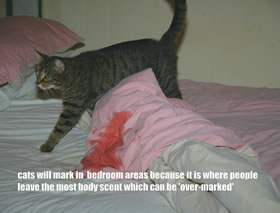 Understanding marking behaviour in home cats is to think like a cat. Human-scent on a bed is a strong as anywhere else in the home and a nervous cat or one that is embroiled in a dispute with another will ‘over-mark’ where the human-cat has marked. Understanding marking behaviour in home cats is to think like a cat. Human-scent on a bed is a strong as anywhere else in the home and a nervous cat or one that is embroiled in a dispute with another will ‘over-mark’ where the human-cat has marked.
“Affection?”
The most deceptive aspect of owner-cat behaviour involves apparent displays of affection when rubbing against them and purring. Almost all a cat’s body is used to possessively mark objects including owners. The head can be used to facially mark, the flanks and paws can be used to mark, and scent glands, most notably those in the anal area, are frequently used to mark objects. Owners like to interpret the feline ‘marking behaviour’ as affection and return the love with human behaviour by giving them strokes and cuddles.
Information about the Norwegian Forest cat
This is one of the newer discoveries in the world of fancy cat breeds.
The Norwegian Forest cat has a distinctive ‘double coat’ that is water resistant which perfectly suited for a woodland and rock outcrop feral lifestyle. In appearance, the Norwegian Forest cat is similar to the long haired Main Coon type. It has the distinction of being fabled in Norse legends as the ‘Fairy Cat’. In its homeland it is known as ‘Norsk skaukatt’ where it is famed for its incredible climbing abilities.
John provided reports on the developments as the 12 week Behaviour-modification Program strategy was implemented.
17/11/08
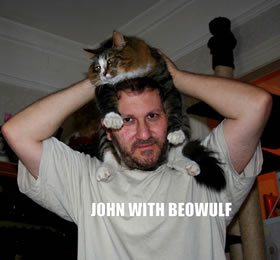 First Report on Beowulf's Behavioural Treatment by John First Report on Beowulf's Behavioural Treatment by John
For a three day period (Sat 8 to Mon 10 November 2008), I was at home and spent a lot of time with all three cats in the same room. My brother was away. Beowulf showed signs of his aggression dissipating. For example, there was an occasion when Sammy sat in the middle of the through lounge. I would be at one end of the room with Beowulf, with the tube of air and the jungles close at hand. I threw the ball for Beowulf to chase across the full length of the through lounge. He ran past Sammy as though he was not there. I repeated the throw four times, and each time Beowulf ran past Sammy without incident.
I put food out in three separate plates, and the three cats ate together for the first time.
At some point in the day, Beowulf approached Sammy and sniffed noses with him. In fact, all through the day, Beowulf appeared relaxed and disinterested in Sammy.
Around mid-afternoon I began to relax my vigil. I think Beowulf must have sensed this, for without warning or incident, he dived at Sammy. Sammy hissed and jumped onto the sofa, and from there leapt on to the top of the sofa’s back rest. At this point, Sammy sat upright and looked down at Beowulf, but did not seek to run further away. Beowulf then jumped onto the sofa and as he was getting ready to spring up at Sammy, I called out Beowulf’s name in a firm, stern voice. I still had the air and jungles in my hand, but I had taken note before the weekend that Beowulf had started to respond to my voice, and I used this occurrence to test the extent. The moment I called out his name, Beowulf froze and turned his head to look at me. Then he turned around and jumped off the sofa, effectively abandoning his hunt.
The rest of the day passed without incident, creating the impression that this demonstration of aggression was a passing phase. The following day (Sunday), remained without incident, my brother out that day, until late evening. When my brother returned home he noted the positive changes in Beowulf and told me how happy he felt that Beowulf’s attitude was as good as healed. He picked Beowulf up and cuddled him, and in an affectionate tone told him how proud he was of him. He then sat on the sofa, still holding and cuddling Beowulf. Some five minutes later, Beowulf jumped off my brother’s lap, onto the floor.
I did not see what happened next. I heard a panicked cry and some hissing from Sammy, who then shot behind the sofa, closely followed by Beowulf. Sammy ran around the sofa and came out the other side. When Beowulf came out, I used the air, followed by the jungles. I then picked him up and put him in the passage, followed by the sound of the clicker and some kibbles. We kept Sammy and Beowulf apart for the rest of the evening.
The following morning (Monday), my brother went to work but I had the day off. I put the cats together again, and kept a close eye. The morning passed without incident, although Sammy was unable to relax and kept a cautious eye on Beowulf. Throughout the morning I put one or the other in the carrier for a half hour or so at a time, so that Sammy would not be in a permanent state of fear. But each time I had them both out of the carrier together, there was no incident. I tried walking out of sight for around 15 seconds to a half minute at a time, and Beowulf remained friendly. Much later on after I had grown confident and somewhat negligent, Beowulf attacked Sammy. There was nothing to trigger the attack, other than me having relaxed my vigil. It’s as though Beowulf senses this. I’m sure he senses some change in me that gives him the assurance that he has a good chance of succeeding in attacking Sammy.
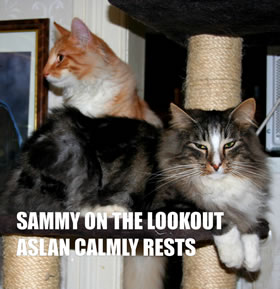 This was also the umpteenth time that Beowulf had demonstrated cunning. He patiently fakes disinterest until he feels that there is opportunity for him to lay into Sammy with good time before we can pull him off. This was also the umpteenth time that Beowulf had demonstrated cunning. He patiently fakes disinterest until he feels that there is opportunity for him to lay into Sammy with good time before we can pull him off.
Again I used my voice instead of the air or the jungles, and he desisted almost immediately. This in itself is a remarkable improvement, because until we contacted you, Beowulf’s bloodlust was so focussed that he became oblivious to everything else. No amount of calling or shouting had an effect. Furthermore, it was difficult to separate him from Sammy after we reached them.
For the past month or so, whenever I see in Beowulf’s eyes or posture that he is contemplating an attack, I show him the air tube and / or the jungles, and this almost invariably causes him to calm his feelings. However, there were and still are occasions when this does not have a permanent effect. He will snap out of it when I show him the air tube and / or the jungles, but within seconds turn again. So I will again show him the air tube and / or the jungles, and he will again calm down, only to turn again within seconds. This procedure either ends with Beowulf coming out of it and walking away, or else it ends with him completely turning and attempt an attack on Sammy. Whereupon I have to discharge the air, jungle, take him outside and give him some food or kibbles to the sound of his name and the clicker.
Summary of the changes to date since enlisting your help
Beowulf has never again gone into the mindset of the possessed cat with that horrible homicidal look. He no longer goes berserk, loses control, or become savagely fixated on his desire to kill Sammy.
Beowulf mindset no longer snaps to the point where he becomes oblivious to the people around him as they call out his name to stop his aggressive behaviour towards Sammy. He responds very quickly to your sound signal system (when we first used them, his response was slow and confused. Now he knows exactly what their purpose is). He now responds to a firm NO command by ceasing his aggressive attack on Sammy.
Beowulf has become cunning in his attacks on Sammy, often feigning disinterest to make us relax our guard. He has developed a strategy of waiting for a likely opportunity of success before he attacks.
Overall conclusion of the treatment to date
Beowulf has demonstrated that he has adapted his approach to achieving his goal, by becoming patient and intellectual in his pursuit. Beowulf’s goal has not changed, only his approach. John, Thursday, 13 November 2008
Second 26/11/08 Report on Beowulf's Behavioural Treatment
Hi David
Beowulf used to regularly jump into my lap whilst watching TV, and begin purring the moment I touched him. And he would stay on me for a long time. But since my brother (Chris) stopped Beowulf from going into his bedroom at night, he has been sulking a lot, and isolating himself.
Beowulf’s unhappiness and self-induced isolation has worried us, and consequently my brother resumed the practise of taking Beowulf to bed with him. Unfortunately, the symptoms you warned us of have manifested in Beowulf’s subsequent behaviour.
If my brother takes Beowulf to bed with him at night, Beowulf becomes aggressive towards Sammy the following morning. He will maintain an intention to attack Sammy throughout the day, no matter how often we use your remote communication system.
On the other hand, if my brother does not take Beowulf to bed with him at night, Beowulf will greatly ease up on his determination to get Sammy, but will sulk a lot and become distant. And no matter how many times we pick him up and stroke him, he will not purr, and will push to get off us.
We have been doing this on and off (i.e. taking him to bed at night for a number of nights, then stopping this practise and then resuming it again, then stopping again, and so on), for the past month or so, and the results have been consistent . We are very concerned of fixing one problem, only to create another serious one.
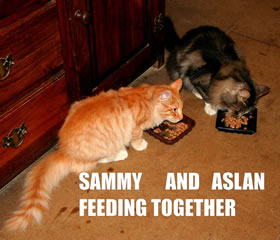 Third Report on Beowulf's Behavioural Treatment Third Report on Beowulf's Behavioural Treatment
Aslan was always more independent and did not mind being alone in the house at night, but Beowulf never could. However we implemented your advice and had Beowulf spend his nights alone. This has made him somewhat sullen. We found that it was possible to keep Beowulf and Sammy together in the same room without any attacks as long as we were aware of them. Beowulf has long since worked out that he is not supposed to molest Sammy.
We live in a tall high ceiling Victorian house, over 4 floors. This means that we have long staircases in the passages. Now if Sammy sees Beowulf alone he panics and runs. When Sammy runs, Beowulf’s mind turns and he goes into attack mode. So even though they may spend a long time together, if Sammy feels scared and runs from Beowulf, Beowulf’s mind clicks and turns and he goes into attack mode and chases Sammy. Such a chase through the passage has in total occurred 4 times. On the last of these occasions Beowulf bit Sammy. Three days later, we noticed that Sammy was walking with a limp and we rushed him to the vet. The vet surmised that he must have been bitten by another cat. After being informed of Sammy’s situation, the vet quickly surmised that Beowulf must have bitten Sammy; and that though the bite had not caused any damage, it had released a toxin via Beowulf’s saliva into Sammy’s system. He therefore diagnosed Sammy with gastritis.
Sammy’s weight on Wed 26/11/2008 was 4.32kg. Today it was 3.56kg. Since then Sammy has made a full physical recovery and now is nearly 5 kilos, which is a greater weight than Beowulf. However Sammy is only 8 months and is emotionally still a kitten and has great fear of Beowulf.
Fourth Report on Beowulf's Behavioural Treatment
We did go ahead and buy 2 new kittens in early December 08
One is silver-black (5-months old); the other is silver-grey with white (7-months old). Neither has been neutered yet
Their introduction into the house was quite surprising. Both are very small cats by Norwegian Forest standards. When we got Mezikial he was skin and bone and Ulysses is a petite cat (with an enormous mane). Mezikial is extremely sweet and went to Beowulf and smelled him; Beowulf hissed and Mezikial ignored the hiss and showed no fear. Ulysses had the same reaction from Beowulf, but he hissed back. But Beowulf has never attacked them. I have even had them spend the night together with no problems.
Sadly, while Beowulf was very attached to Braqui, and ironically we got Sammy for Beowulf as a Braqui replacement, he is unable to become very friendly with the new kittens. Aslan’s reaction has on the other hand been the opposite. He welcomed the kittens and is very happy that they are home. He now spends more time at home with them and less time in the garden alone. Also he was always a difficult cat to feed, going long period without eating and then eating only sparingly. Since the kittens arrived he eats more and has finally gained some much needed weight
When a kitten approaches Beowulf, he may hiss and usually will walk away under the table with his shoulders drooped. However, with Sammy, Beowulf’s mind turns; and he still attacks him. On occasions when Beowulf bumps unexpectedly into Sammy, Beowulf occasionally exhibits fear, before becoming aggressive. Sammy is a ginger cat, and it has been suggested to me that it is Sammy’s colour that triggers Beowulf’s aggression towards him.
Sammy and the two kittens get on very well. They play together, sleep together and playfully chase each other. Beowulf and Aslan get on well together, too. Aslan gets on well together with all the cats. Beowulf does not attack them and will even sleep on the same bed as them but he refrains from “connecting” with and being friendly.
I will give you a phone call in a few days for you feedback.
Kind Regards Chris & John
I have always planned on having at least 4 cats. I also want a fourth cat as a companion for Sammy. Obviously, Beowulf is antagonistic towards Sammy, whereas Aslan is ambivalent. I’m sure that Aslan loves Sammy, but is reluctant to play with him. Sammy often starts a play-fight with Aslan, and as Aslan is not a kitten anymore he does not have Sammy’s appetite for constant play. Sometimes Aslan moans and complains if the play-fight lasts too long. Sammy always starts the play-fights, often pinning Aslan down and going through all the play-fighting motions, with Aslan either trying to run away, or else reluctantly fighting back in an aggrieved playful manner. Sammy even grooms Aslan, licking his ears and head. But Aslan does not groom Sammy.
Which brings me to relate something amazing to you. A breeder has sent me a photo of a six-month old kitten she has on offer, who looks like a cross between Beowulf and Aslan. He has Beowulf’s face and Aslan’s body. It’s quite uncanny. I wish to bring the new cat home now as a playmate for Sammy. I would appreciate your input.
John Tuesday, 25 November 2008
Summary from Dr David Sands
Until John and Chris began implementing our Behaviour-modification Program the aggressive episodes involving ‘Beowulf’ were escalating. What the strategy achieved was to reduce the natural competition between the cats and prevent the family from reinforcing the problem behaviours. The introduction of more cats into the group then began to dilute the one-to-one competition.
Anyone wishing to know more about the Program and costs should telephone the Animal Behaviour Clinic, Chorley Lancashire (01257 249960 Monday to Saturday 10 - 7 pm) or email Dr David Sands at drdavidsands@aol.com
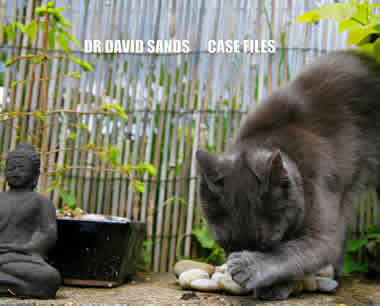
|







